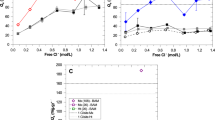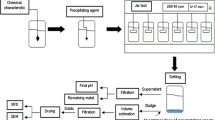Abstract
This article is devoted to the influence of sodium lignosulfonate (SL), anionic surfactants (sodium dodecylsulfate (SDS), sodium dodecylbenzene sulfonate (SDBS)), and their mixtures on the copper cementation rate by zinc. The results demonstrated a copper cementation rate decreasing at LS and SDBS concentrations increasing. Excessive zinc consumption was also detected on copper-ion cementation due to LS and SDBS anion adsorption onto positively charged zinc cathodic areas and copper particles. This led to a decrease in the growth rate of nuclei of copper particles and energy consumption for the formation of new nucleation centers, as well as the creation of conditions for reducing the overvoltage of hydrogen evolution. At the same time, an increase in temperature led to zinc consumption decreasing in the presence of LS. The reagents under investigation could be ranked according to their degree of negative influence on copper cementation increasing in the following order: SDS < SDBS < LS. Testing LS and SDS mixtures showed their irregular influence on the copper cementation rate at different temperatures. In experiments with LS and SDBS mixtures, a linear decrease in the copper-ion cementation rate upon an increase in SDBS concentration and simultaneous zinc-consumption enhancement was fixed. Due to the negative influence of the investigated reagents, we offered a purification method from organic impurities through the use of multilayered alumosilicates modified by cationic surfactants. The results indicate the high effectiveness of removing organic impurities from solutions, which allowed us to increase the cementation rate in the presence of the LS and SDBS mixture by 50% while, at the same time, decreasing zinc consumption.




Similar content being viewed by others
REFERENCES
Alfantazi, A.M. and Dreisinger, D.B., Foaming behavior of surfactants for acid mist control in zinc electrolysis processes, Hydrometallurgy, 2003, vol. 69, nos. 1–3, pp. 57–72. https://doi.org/10.1016/S0304-386X(03)00002-1
Freire, N.H.J., Majuste, D., Angora, M.A., and Ciminelli, V.S.T., The effect of organic impurities and additive on nickel electrowinning and product quality, Hydrometallurgy, 2017, vol. 169, pp. 112–123. https://doi.org/10.1016/j.hydromet.2016.12.009
Dang, D.M.T., Dang, C.M., and Fribourg-Blanc, E., Investigation of the influence of different surfactants on controlling the size of silver nanoparticles, Int. J. Nanotechnol., 2015, vol. 12, nos. 5–7, pp. 505–514. https://doi.org/10.1504/IJNT.2015.067908
Yue, S.X., Su, Y.C., Luo, Z.B., Yu, Q.S., Tursun, R., and Zhang, J., Influence of surfactant interaction on ultrafine copper powder electrodeposition, Materialwiss. Werkstofftech., 2019, vol. 50, no. 7, pp. 856–863. https://doi.org/10.1002/mawe.201800103
Demeev, B.B., Dauletbay, A., and Nauryzbaiev, M.K., The effect of organic surface-active additives upon the kinetics of electrodeposition of ultrafine copper powder, Chem. Eng. Trans., 2016, vol. 47, pp. 211–216. https://doi.org/10.3303/CET1647036
Li, Q., Zhao, Y., and Zhang, C., Influence of cetyltrimethylammonium bromide and sodium lauryl sulfate on production of zinc powders by alkaline electrowinning, Russ. J. Non-Ferrous Met., 2014, vol. 55, no. 1, pp. 65–72. https://doi.org/10.3103/S1067821214010131
Salem, J.K., Hammad, T.M., Almoqayyed, S., and Hejazy, N.K., Influence of cationic surfactant and temperature on the growth of ZnO nanoparticles, Tenside, Surfactants, Deterg., 2018, vol. 55, no. 3, pp. 188–195. https://doi.org/10.3139/113.110563
Owusu, G., Dreisinger, D.B., and Peters, E., Interfacial effects of surface-active agents under zinc pressure leach conditions, Metall. Mater. Trans. B, 1995, vol. 26, no. 1, pp. 5–12. https://doi.org/10.1007/BF02648972
Owusu, G. and Dreisinger, D.B., Interfacial properties determinations in liquid sulfur, aqueous zinc sulfate and zinc sulfide systems, Hydrometallurgy, 1996, vol. 43, nos. 1–3, pp. 207–218.
Owusu, G., Peters, E., and Dreisinger, D.B., Surface tensions and contact angles due to lignin sulphonates in the system: Liquid sulphur, aqueous zinc sulphate and zinc sulphide, Can. J. Chem. Eng., 1992, vol. 70, no. 1, pp. 173–180. https://doi.org/10.1002/cjce.5450700125
Karavasteva, M., The effect of certain surfactants on the cementation of copper by suspended zinc particles, Hydrometallurgy, 1996, vol. 43, nos. 1–3, pp. 379–385.
Karavasteva, M., The influence of copper on the effect of certain surfactants during the cementation of cadmium by suspended zinc particles, Hydrometallurgy, 1998, vol. 48, no. 3, pp. 361–366.
Karavasteva, M., The effect of certain surfactants on the cementation of nickel from zinc sulphate solutions by suspended zinc particles in the presence of copper, Can. Metall. Q., 1999, vol. 38, no. 3, pp. 207–210. https://doi.org/10.1016/S0008-4433(99)00008-7
Karavasteva, M., The effect of certain surfactants on the cementation of cobalt from zinc sulphate solutions by suspended zinc particles in the presence of copper or antimony, Can. Metall. Q., 2001, vol. 40, no. 2, pp. 179–184. https://doi.org/10.1179/000844301794388416
Granata, G., Tsendorj, U., Liu, W., and Tokoro, C., Direct recovery of copper nanoparticles from leach pad drainage by surfactant-assisted cementation with iron powder, Colloids Surf., A, 2019, vol. 580, p. 123719. https://doi.org/10.1016/j.colsurfa.2019.123719
Begletsova, N., Selifonova, E., Chumakov, A., Al-Alwani, A., Zakharevich, A., Chernova, R., and Glukhovskoy, E., Chemical synthesis of copper nanoparticles in aqueous solutions in the presence of anionic surfactant sodium dodecyl sulfate, Colloids Surf., A, 2018, vol. 552, pp. 75–80. https://doi.org/10.1016/j.colsurfa.2018.05.023
Cheng, X., Zhang, X., Yin, H., Wang, A., and Xu, Y., Modifier effects on chemical reduction synthesis of nanostructured copper, Appl. Surf. Sci., 2006, vol. 253, pp. 2727–2732. https://doi.org/10.1016/j.apsusc.2006.05.125
Zaabar, A., Aitout, R., Amoura, D., Maizia, R., Makhloufi, L., and Saidani, B., Effect of nettle plant extract on the overconsumption diminution of zinc as sacrificial metal during cementation of copper, Miner. Eng., 2019, vol. 142, article no. 105933. https://doi.org/10.1016/j.mineng.2019.105933
Zaabar, A., Aitout, R., Makhloufi, L., Alilat, K., Maziz, S., and Saidani, B., Effect of nettle plant extract on the cementation of copper onto zinc in acidic sulfate solutions, Hydrometallurgy, 2013, vol. 136, pp. 58–64. https://doi.org/10.1016/j.hydromet.2013.03.004
El-Saharty, A.A., El-Nammamy, N.H., and El-Araby, H.A., Sodium diethyldithiocarbamate as accelerator of the rate of copper cementation, Egypt. J. Aquat. Res., 2015, vol. 41, pp. 289–293. https://doi.org/10.1016/j.ejar.2015.08.002
Kolmachikhina, E.B., Ryzhkova, E.A., Dmitrieva, D.V., Sviridov, V.V., and Naboichenko, S.S., Lignosulfonate, anionic surfactants and their mixtures influence on water solutions surface tension and zinc concentrate pressure leaching, IOP Conf. Ser.: Mater. Sci. Eng., 2019, vol. 525, no. 1, p. 012023. https://doi.org/10.1088/1757-899X/525/1/012023
Khazieva, E.B., Sviridov, V.V., Menshchikov, V.A., and Naboychenko, S.S., Influence of surface-active substances on sulfur state during the autoclave leaching of zinc concentrates, Tsvetn. Met. (Moscow, Russ. Fed.), 2017, no. 2, pp. 46–50.
Ordinartsev, D.P., Sviridov, A.V., and Sviridov, V.V., Extracting vanadium, molybdenum, and tungsten from acidic solutions via adsorption on modified montmorillonite, Russ. J. Phys. Chem. A, 2018, vol. 92, no. 10, pp. 2060–2064. https://doi.org/10.1134/S0036024418100229
Funding
This work was supported by the Russian Foundation for Basic Research as part of scientific project no. 18-38-00388.
Author information
Authors and Affiliations
Corresponding authors
Ethics declarations
The authors declare that they have no conflicts of interest.
Additional information
Translated by Sh. Galyaltdinov
About this article
Cite this article
Kolmachikhina, E.B., Sviridov, A. & Naumov, K.D. Investigation into the Influence of Sodium Lignosulfonate, Anionic Surfactants, and Their Mixtures on the Copper Cementation Rate by Zinc. Russ. J. Non-ferrous Metals 61, 488–493 (2020). https://doi.org/10.3103/S1067821220050077
Received:
Revised:
Accepted:
Published:
Issue Date:
DOI: https://doi.org/10.3103/S1067821220050077




